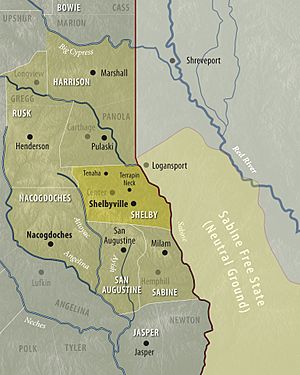Regulator–Moderator War facts for kids
Quick facts for kids Regulator–Moderator War |
||||||||
|---|---|---|---|---|---|---|---|---|
 Location |
||||||||
|
||||||||
| Belligerents | ||||||||
| Regulators | Moderators | |||||||
| Commanders and leaders | ||||||||
| Charles W. Jackson † Charles W. Moorman |
Edward Merchant John M. Bradley James J. Cravens |
|||||||
| Casualties and losses | ||||||||
| 52 killed total 40 killed during the feud 12 more killed in the aftermath |
||||||||
The Regulator–Moderator War, also known as the Shelby County War, was a big fight between two groups in East Texas. It happened from 1839 to 1844, when Texas was its own country, the Republic of Texas. This conflict started as a disagreement over who owned land. Soon, it turned into a violent struggle for power and money in the area. People started raiding homes, stealing animals, and even killing each other. More than 40 people died in this conflict.
A Lawless Land
Long ago, the United States and Spain couldn't agree on where their border was between Spanish Texas and Louisiana Territory. Because they didn't want to fight a war over it, they left a strip of land alone. This area became known as the Neutral Ground. It was a wild place where no country was truly in charge.
This lawlessness spread into nearby parts of East Texas. Even after Texas won its independence from Mexico, the land stayed wild and dangerous.
The War Begins
The Regulator–Moderator War was a land dispute that mainly took place in Harrison and Shelby counties. It lasted from 1839 to 1844. Over time, the fighting spread to other East Texas counties like Nacogdoches and San Augustine.
The main leaders of the Regulators were Charles W. Jackson and Charles W. Moorman. For the Moderators, the leaders were Edward Merchant, John M. Bradley, and James J. Cravens. Their disagreements grew from problems like land scams, cattle theft, and revenge killings. Many people had died over the years because of these issues.
The conflict became very serious after Charles W. Jackson shot Joseph Goodbread in 1840. Jackson then formed a group called the Regulators. He said their goal was to stop "cattle rustling," which means stealing cattle. In response, Edward Merchant organized the Moderators to try and control the Regulators.
When Charles Jackson went to court in 1841, the Regulators caused so much trouble that the trial couldn't continue. Open fighting then broke out, with people being killed and houses being burned down.
Escalation and Peace Efforts
Later, Charles Jackson and a friend were attacked and killed by the Moderators. Charles Moorman then took over as the leader of the Shelby County Regulators. Moorman led a group to get revenge for Jackson's death. They found the attackers and brought them to justice.
In the summer of 1844, the Moderators changed their name to the Reformers. They chose James J. Cravens as their new leader and decided to take control of Shelbyville.
Republic of Texas President Sam Houston was tired of the constant fighting. He sent George W. Terrell to investigate the chaos. Terrell wrote to Houston that it seemed like society was falling apart.
On August 14, 1844, President Houston ordered Travis G. Broocks and Alexander Horton to lead 500 soldiers into East Texas. Their mission was to bring peace between the two groups. Houston himself rode to East Texas and set up his headquarters in San Augustine. He worked hard to be fair to both sides. Through his efforts, he managed to get the groups to sign a peace treaty on July 24, 1844. This agreement promised to protect "good and unoffending citizens."
After the War
Even though the Texas government said the feud officially ended in 1844, violence continued for several more years. For example, in 1847, a Moderator supporter named Wilkerson held a wedding party. He invited some Regulators, but the food and drinks served made over 60 of them very sick, and about 10 died. The Regulators got revenge by capturing and punishing Wilkerson.
The fighting finally stopped when the Mexican–American War began. Both Regulators and Moderators put aside their differences and joined together to fight for Texas.
Harrison County Sheriff John J. Kennedy and county judge Joseph U. Fields also helped bring an end to the conflict by supporting law and order. Regulator leader Charles W. Moorman was killed in 1850.

